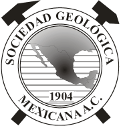|
BOLETÍN DE LA SOCIEDAD GEOLÓGICA MEXICANA, V. 52, n. 3, (2000) 11-20 http://dx.doi.org/10.18268/BSGM1995v52n3a2 |
|
Avances en el estudio de la fauna de vertebrados jurásicos del Cañon del Huizachal, Tamaulipas, México
Marisol Montellano-Ballesteros1, René Hernández-Rivera1, James M. Clark2 , David E. Fastovsky3, Víctor Hugo Reynoso-Rosales4, Nicholas H. Strater3, James A. Hopson5
1 Instituto de Geología, Universidad Nacional Autónoma de México, Ciudad Universitaria, Delegación Coyoacán. 04510 D.F.
2Department of Biological Sciences, The George Washington University, Washington, D. C.. 20052.
3Departament of Geology, University of Rhode Island, Kingston. R.l.02881-0807.
4Redpath Museum, McGill University, Montreal, Quebec, Canadá H3A 2K6.
5Department of Anatomy and Organismal Biology, Universily of Chicago, Chicago, Ill. 60637.
Abstract
Mexican continental Mesozoic deposits are poorly known. Most of the known scattered localities are of Cretaceous age. Dinosaur remains are the main faunal component, but in Baja California Norte sorne Cretaceous mammalian material has been described.
In 1985, Clark and Hopson described a new lrytilodontid (Bocatherium mexicanum) collected in the Cañon del Huizachal, in Tamaulipas. Since then, an intemational cooperative project has been developed in the area. Field work has yielded a fossil vertebrate collection of nearly 5,000 specimens.
The faunal assemblage is diverse and includes the tritylodontid (B. mexicanum), at least six mammalian species, a neosuquian crocodile, a pterosaur of rhamphorhynchoid grade, three formos of sphenodontids, a burrowing primitive diapsid Tamaulipasaurus morenoi, and fragmentary dinosaur remains. This area is the oldest Mcsozoic vertebrate. bearing continental locality from Mexico and the second bearing Mesozoic mammals.
The study area is also interesting from the taphonomic and sedimentological point of view, because it represents a waterlain sequence of pulsed debris flows. This is an uncommon deposltional setting in which to find microvertebrates. Usually' they are found in flood plains of fluvial channels.
The fossil assemblage suggests an early-mid Jurassic age, which is another reason why this locality is of great ímportance. Few localities of this age are known from anywhere in the world. The study of this fauna will also yield information about the vertebrate biodiversity of this period, and provides elements to test the hypothesis that there was low tetrapod diversity after a postulated Late Triassic extinction and not the subsequent explosive adaptive radiation; instead the Jurassic faunas kept a relatively low diversity.
Keywords: Jurassic, continental vertebrate, Mexico.


